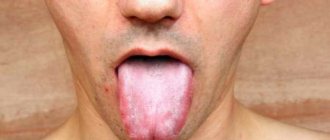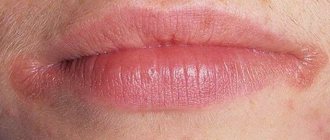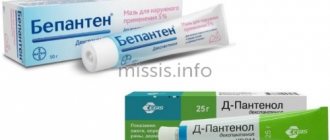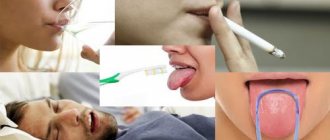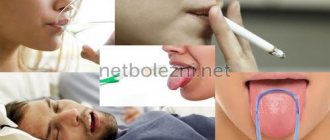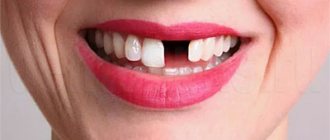Cracks in the corners of the mouth are the main symptom of angulitis. This is a disease of the mucous membrane and skin that develops under the influence of streptococci or yeast-like fungi. Diabetes mellitus, problems with bite, lack of vitamin B2 and even long-term antibiotic therapy also contribute to the occurrence of cracks. Why is the skin in the corners of the mouth prone to cracking, how to neutralize and prevent the development of the process in the future?
General characteristics of the condition
Painful cracks around the mouth are colloquially called jams. Zaeda is one of the forms of stomatitis (damage to the oral mucosa) caused by streptococci or yeast-like fungi of the genus Candida. In some cases, doctors diagnose mixed infection (angular stomatitis).
The following angulitis are distinguished: allergic (when using lipstick or other cosmetics), microbial (streptococcal, candidiasis, etc.) and post-traumatic (postoperative, post-manipulation, etc.). Microbial angulitis most often occurs in patients with diabetes mellitus (streptococcal) or in HIV-infected people (candidomycosis). Microbial angulitis in children can occur due to intestinal dysbiosis, vitamin deficiency, decreased immunity and other diseases. Post-traumatic (postoperative) angulitis is cracks in the skin and mucous membranes (linear tears in the skin or mucous membrane) in the area of the corner of the mouth, resulting from excessive (excessive) stretching after intraoral surgical dental operations (removal of dystopic or impacted wisdom teeth) or manipulations associated with treatment of wisdom teeth. Almost after every removal of an impacted or dystopic wisdom tooth, maxillary sinusotomy or other surgical interventions that require wide opening of the mouth, damage (by stretching) to the surface layers of the skin and mucous membrane in the area of the corner of the mouth occurs, i.e. post-traumatic (postoperative) angulitis.
Morphological features
Streptococcal angulitis most often develops in patients of the younger age category. First, a small bubble appears in the corners of the mouth, covered with a thin film. Later, erosion forms at the site of the bubble, covered with a crust of congealed blood and purulent masses. When the blister is opened, moist red skin with traces of minor bleeding is exposed. You can often find a crack in the center of the bubble. Approximately 1-2 hours after opening, the skin again becomes covered with a dense crust.
Content:
- General characteristics of the condition
- Possible reasons for development
- Features of therapy and prevention
Streptococcal infection of the mucous membrane is accompanied by discomfort and pain when opening the mouth.
Seizures of fungal origin are slightly different from streptococcal ones. Initially, a varnish-red erosion forms on the mucosa, surrounded by an additional layer of epithelium. Sometimes erosion is covered with a grayish coating. A specific crust does not form in case of candidiasis angulitis. Most often, the crack is masked by an overhanging skin fold and has a chronic, relapsing course.
Why do lips crack and peel, and what can you do about it? Expert advice
We asked dermatologists what to do if your lips peel and crack, and how to properly care for them if the balm does not help.
Experts:
- Olga Fem is a cosmetologist-esthetician with a medical education, the founder of the website kosmetologa.net.
- Alexander Prokofiev is a dermatovenerologist, medical expert of the La Roche-Posay brand.
- Svetlana Kovaleva is a dermatologist and cosmetologist.
- Evgenia Reshetnikova is a dermatovenerologist, cosmetologist, and head of the medical department at Sesderma.
What causes lips to become dry and flaky?
Most often due to improper care. For example, lack of protection when it is needed.
The fact is that lips are deprived of natural defense mechanisms. This zone is a transition zone between the skin of the face and the oral mucosa, so the skin here has an atypical structure. It is thinner (three layers, not five, no shiny or grainy). The upper stratum corneum is also very thin, and complete keratinization does not occur in it (which is why the lips are soft). The skin of the lips does not contain melanin and is not able to reflect the effects of sunlight. It has a reduced ability to accumulate and retain water. Moisture evaporates much faster than from other areas of the face, and this leads to dryness, flaking, and the risk of inflammation.
Okay, this is in general, but more specifically, why do peeling appear?
There are external and internal reasons. External:
1. You do not use balm before going outside in cold weather (frost, wind). It creates an occlusive film on the surface of the lips, which prevents moisture evaporation and serves as a protective barrier.
2. You do not use a balm with SPF during periods of increased solar activity.
“Because the skin of the lips does not contain melanin, it cannot tan, but it can get burned. A burning sensation and dryness appear,” explains Evgenia Reshetnikova. “ An ordinary balm, without a sun protection factor, does not work here. On the contrary, you risk increasing the skin's sensitivity to ultraviolet radiation : the balm, like a lens, will increase exposure to rays.
It is advisable to use a balm with SPF in winter, especially if you are into mountain sports: snow reflects the sun's rays. Apply the product before going out into the sun and reapply every 1.5-2 hours.”
3. Dry air at home and in the office . It is known that hot dry air (from batteries, heaters) dries out the skin. But cold (from the air conditioner), according to experts, is no better.
“It is advisable to maintain humidity at 40-60%,” advises Olga Fem. “Unfortunately, 30% in an apartment in winter is a common occurrence. Buy a humidifier if possible."
4. You lick or bite your lips when you're nervous. Try to keep an eye on this.
5. You breathe through your mouth , and this quickly dehydrates your skin. We need to fight the cause of nasal congestion.
6. You regularly go to a dry (Finnish) sauna, a swimming pool with chlorinated water, and often swim in the sea . The same advice - use balm.
7. Frequent and unnecessary use of lip balm.
Olga Fem: “ Balm and hygienic lipstick are not products for regular care, but for temporary protection. With constant use, they worsen the condition of the lips. Why is that? A barrier film on the surface of the skin prevents moisture evaporation. In certain situations this is useful - for example, in the cold. But, in general, evaporation is a natural physiological process. If the balm is constantly on the lips, the cells do not receive a signal that the natural barrier needs to be repaired - after all, there is an artificial one on the lips. Over time, this leads to the fact that you cannot do without chapstick at all. It’s similar to the situation with smoking: another cigarette quickly relieves discomfort, but it also maintains addiction. How to break the vicious circle? Stop using balms and hygienic lipsticks for no reason.”
“Balm is a means for temporary protection, and not for regular care,” - Olga Fem
8. You unknowingly apply facial care to your lips . If it's a regular moisturizer, no problem. But acne treatment products (especially those with retinol and its derivatives) can cause dryness and flaking when they come into contact with the skin of the lips.
9. When brushing your teeth, the paste gets on the skin of your lips. Menthol and eucalyptus essential oil, even with minute contact with lips, provoke dryness.
View this post on Instagram
Posted by Andrea (@girlgreybeauty)
In addition, there are internal causes of dry and flaky lips:
- Dehydration of the body . “It can occur if a person drinks a lot of coffee and little clean water or abuses alcohol,” says Olga Fem.
- Chronic stress.
- Frequently recurrent episodes of herpes infection.
- Gut microbiome disruption.
- Allergic reaction to cosmetics, food, medicines.
- Excess or deficiency of vitamins and minerals.
- Drug therapy. In particular, such side effects sometimes occur when taking Roaccutane.
- Skin diseases - dryness can be a sign of exacerbation of atopic dermatitis, eczema, neurodermatitis, psoriasis.
- Cheilitis is a general term for inflammatory processes of the skin of the lips of various types. They occur against the background of individual hypersensitivity to UV rays or frost, hyperfunction of the salivary glands, immunoallergic changes, anxiety and depressive disorders and other factors.
- Other chronic and infectious diseases. We won’t list them so as not to scare you, but many pathologies are accompanied by dry lips.
How can you understand that your lips are peeling, for example, due to dry air, and not some kind of disease?
“If the peeling is not very strong, most likely it is caused by bad weather, dry air or the habit of licking your lips,” says Alexander Prokofiev, “But if redness, thickening, burning, disturbance of the skin texture, cracks appear, you need to consult a dermatologist.”
If the problem is episodic or seasonal - for example, it arose with the onset of cold weather, during a vacation at the seaside, or you started going to the pool or using matte lipstick more often than usual - you also don’t have to worry.
“After eliminating the cause or adjusting the care, this dryness will go away on its own,” says Olga Fem. “If you don’t notice any changes after a month, it’s better to go to the doctor. Not necessarily to a dermatologist, but to a therapist. The main thing is not to think about the worst. If there are serious problems in the body, most likely, dryness and flaking will not be the only symptoms. More likely, it’s a matter of insufficient or improper care.”
“Cracks are a more severe symptom than peeling. It’s best to immediately contact a dermatologist,” - Alexander Prokofiev
View this post on Instagram
Posted by Andrea (@girlgreybeauty)
Why does the skin of the lips not just peel off, but crack? What to do about it?
“Cracks are a more severe symptom than peeling. It’s best to see a doctor right away,” says Alexander Prokofiev. Svetlana Kovaleva insists on the same thing: “Do not self-medicate, go to a gastroenterologist and endocrinologist. Cracks on the lips always indicate the presence of a secondary infection. They can occur against the background of various deficiency conditions and diseases - from lichen planus to diabetes mellitus and oncology.”
What to do right now, before the doctor sees you?
Avoid irritating (salty, spicy, sour) foods for a while. Do not tear off skin flakes and crusts. "You can apply an over-the-counter wound-healing, antibacterial agent that is allowed to be used on the outer mucous membrane - says Svetlana Kovaleva - For example, Topicrem Cica or Avene Cicalfate+ restorative cream, or La Roche-Posay Cicaplast Baume B5 balm."
- Expert tip: Topicrem Cica revitalizing cream
- Expert tip: Avene Cicalfate+ Revitalizing Cream
- Expert tip: La Roche-Posay Cicaplast Baume B5 balm
What causes cracks in the corners of the lips?
Evgenia Reshetnikova: “This is how angular cheilitis manifests itself (in everyday life they say “jams”), it occurs when there is a bacterial or fungal infection of the lips. The causative agents can be streptococci or fungi of the genus Candida. I don’t recommend treating cheilitis on your own; this should be done by a specialist.”
They say that earwax helps with sticking in the corners of the lips. Is there any explanation for this? What does it contain?
There are two types of earwax, dry and wet. Research confirms that the dry form has antimicrobial properties. It contains immunoglobulins and peptides that prevent the development of bacteria and fungi. On the contrary, wet earwax creates a breeding ground for bacteria and promotes their proliferation.
The type of earwax is determined genetically. It is believed that the descendants of Europeans often have wet sulfur, while those from East Asia tend to have dry sulfur.
Why do children have cracked lips?
“Most often due to fungal microflora or against the background of atopic dermatitis, cheilitis is one of its symptoms. You need to consult a doctor,” repeats Svetlana Kovaleva.
View this post on Instagram
Posted by Jazmina Daniel (@missjazminad)
And if you drink vitamin A, vitamin E or a complex, will your lips recover faster? And in general, is it useful for prevention?
Lips can actually peel due to a lack of vitamins A, E, D, B12 and iron. But you can take any vitamins, microelements and complexes only as prescribed by a doctor, subject to a deficiency confirmed by laboratory tests .
“Having discovered signs of iron deficiency (pale skin, circles under the eyes), you can eat and drink all imaginable dietary supplements and not get results, because at the same time there was a lack of vitamin B and carrier protein,” explains Svetlana Kovaleva. Her opinion is supported by Evgenia Reshetnikova: “If you choose your own vitamins and their dosage, there is a risk of getting hypervitaminosis and corresponding negative consequences.”
“Yes, you can read on the Internet that some person took vitamin E, and it helped him,” continues Svetlana Kovaleva. “But a lack of vitamin E causes peeling and cracked lips in a very small number of cases. Most likely, that person was lucky by chance. The same applies to traditional methods of treatment: those who have been helped declare it publicly. The other 50 people who felt no better, or even worse, are unlikely to write about it on the Internet. It’s embarrassing to admit that you applied, for example, melted fat to your lips and hoped that it would help.”
So in the end – how to take care of your lips? How often can I use the balm?
Check list:
- Apply the cream to your lips morning and evening.
Which cream to use - a special one for the lips or an existing one for the eyelids - is at your discretion. Dermatologists have different opinions.
“There are special lip creams, but personally I think this is not necessary,” says Olga Fem. “You can use a moisturizing or anti-age eyelid cream. The skin around the eyes is also thin and sensitive, and products designed for this area are suitable for lip care.”
Svetlana Kovaleva believes that eye creams can be applied around the lips - but not on the lips.
“If the manufacturer does not directly indicate that the product is suitable for the red border of the lips, then you should not apply it there. When you drink tea, have lunch, or simply lick your lips, the cream will get onto the mucous membrane and into the gastrointestinal tract, and potential risks are not monitored. For example, insulin is released when glucose enters the oral mucosa at a normal acidity level of pH7. If the balance changes, it has a negative impact. Therefore, I advise you to use only those creams that are specifically designed for lips. There is no 100% guarantee that all of them were tested for oral use (since we are talking about cosmetic care, not a medical drug). But at least there is confidence that the manufacturer took this scenario into account when developing the product.”
- Expert advice: Moisturizing cream-protector for lips Silcses, Sesderma. Price – 1525 rub.
- Expert advice: Instant lip balm + prolonging cream activator Fillderma Lips, Sesderma . Price – 3530 rub.
- Total Lip Treatment lip cream . Price – 6505 rub.
- Editor's Choice: Arctic Hydra Care Rich Lip Cream, Lumene. Price – 665 rub.
- Editor's choice: Wine Elixir lip cream, Apivita. Price – 2228 rub.
2. To determine how often to use a balm, choose which of the following descriptions best describes your lips:
Option A) - During the year, your lips are more often in normal condition than in problematic condition. Usually they don't bother. Dryness and peeling appear sporadically.
Option B) – During the year, your lips are more likely to be in a problematic condition. They regularly dry out and peel, and this does not depend on the season. They always want to smear something on them.
If you chose option “A”, use the balm when:
- going outside in cold windy weather;
- going to the beach / for a walk in the city during maximum solar activity (renew balm with SPF every 1.5-2 hours);
- skiing/snowboarding on a sunny day (SPF!);
- go to the sauna or swimming pool.
- Topicrem Ultra-Moisturizing Lip Balm . Price – 537 rub.
- Regenerating barrier balm for children and adults Cicaplast, La Roche-Posay . Price – 528 rub.
- Expert tip: Repaskin Lips Sunscreen SPF 50, Sesderma . Price – 1990 rub.
- Editor's choice: Nourishing lip balm Apaisac, Biorga. Price – 495 rub.
- Editor's Choice: Neutrogena Lip Balm. Price – 250 rub.
- Editor's Choice: Carmex Lip Balm. Price – 350 rub.
- Editor's choice: Lips 101 lip balm, Lanolips. Price – 1290 rub.
- Editor's choice: Nutricia Baume Levres Cocoon Balm, Payot. Price – 1595 rub.
- Editor's choice: the Lip Balm, La Mer. Price – 5300 rub.
If you chose option “B”, a dermatologist should advise you on the balm and the mode of its use.
“There are people who have a tendency to cheilitis. They need to use preventive balms every day, sometimes several times a day. For selection, you should consult a dermatologist,” recommends Svetlana Kovaleva.
3. Drink more water, less dehydrating drinks (coffee, soda, energy drinks).
4. Get rid of the habit of licking your lips and biting off dry scales. This prevents your skin from recovering normally.
Additionally: it is useful to buy an air humidifier and do self-massage. “In the lip area is the orbicularis oris muscle. Massage of this area activates metabolic processes, improves blood circulation and the appearance of the lips. In this video I show how to do it,” Olga Fem.
What about lip scrubs? Are they useful?
“If you are not concerned about the condition of your lips, you do not need to exfoliate them with anything additional. The skin is renewed naturally. If you feel the need to scrub, then there’s probably a reason? Peeling? – says Svetlana Kovaleva. “In this case, you need to diagnose what’s wrong. The scrub will not affect the cause of the problem, but may injure thin skin. I am convinced that scales should never be removed by force. Very high risk of subsequent pathological processes. Only softening and moisturizing with special balms and creams.”
Olga Fem believes that, if necessary, you can use soft enzyme peels without abrasive particles - the same ones that are intended for the face (but try not to lick your lips!) They are less traumatic compared to scrubs.
If I wear lipstick or gloss every day, does it have a bad effect on my lips? Even when they are claimed to be moisturizing?
Mineral oil/wax based lipsticks and lip glosses can work as a protective barrier in the cold. But using them daily will most likely lead to dryness. Moisturizing components evaporate after 1-2-3 hours (depending on the specific product). After this, it is advisable to update the lipstick, but not everyone does this and not always.
Evgenia Reshetnikova: “Most glosses and lipsticks do not contain SPF and do not protect against ultraviolet radiation. Quite the contrary: the pigments included in their composition are often photosensitizers and increase skin sensitivity to the sun.”
I heard that they are now injecting hyaluronic acid to moisturize (not plump) the lips. Worth a try?
They work on the principle of biorevitalization: they introduce hyaluronic acid into the skin, which becomes less abundant with age. The moisturizing effect does not last long, about 1-1.5 months. Since in the body this polysaccharide is broken down by enzymes.
“Such manipulations should be discussed individually with a cosmetologist. I believe that they are justified in cases of age-related deficiency of hyluuronic acid, a decrease in the quality and quantity of collagen, and weakening of muscle tissue. In other cases, it is better to use therapeutic methods,” says Svetlana Kovaleva.
View this post on Instagram
Posted by Andrea (@girlgreybeauty)
Stupid question: what condition of the lips is considered normal?-) Maybe they are fine, but I consider them dry because I have seen enough photoshopped portraits on Instagram?
The norm is considered to be a condition that does not cause discomfort.
“It’s easy to check whether you are properly caring for the skin of your lips,” says Olga Fem. “In the morning, wash your face with filtered or boiled water and do not apply any cream or lipstick to your lips. It's better to choose a day when you can stay home.
If you take proper care of your lips, one day without cream and balm will not lead to dryness. You won’t feel the urge to apply anything, you’ll feel comfortable.”
Our experts:
Olga Fem
Cosmetologist-esthetician with medical education, creator of the website kosmetologa.net, Instagram – @olgafem. YouTube channel – Cosmetologist.net.
Svetlana Kovaleva
Dermatologist, cosmetologist, Educational.
Evgenia Reshetnikova
Dermatovenerologist, cosmetologist, head of the medical department of Sesderma.
Alexander Prokofiev
Dermatovenerologist, medical expert at La Roche-Posay. Works in . Participated in clinical trials of drugs.
Instagram @dr.prokofyev
Possible reasons for development
The appearance of a jam indicates not only infection or internal pathological processes, but also the bad habits of the person himself. Regularly licking your lips is a ritual that some people find extremely difficult to break. It is important to understand that regular exposure to saliva, which contains billions of bacteria, has a detrimental effect on the mucous membranes. If a crack has already formed, licking the lips interferes with regeneration and further fuels the infection.
Neglecting the rules of personal hygiene is also fraught with the development of cracks in the corners of the mouth. Possible causes include: microtraumas, lack of cleansing, dirt on the skin.
Eating in childhood most often indicates iron deficiency anemia. Therefore, all pediatricians advise immediately taking a blood test for iron, and not sinning on problems with the baby’s hygiene. The main thing is not to try to correct anemia on your own. Introducing meat and pomegranates in large quantities into the diet can only maintain the existing iron level, but not increase it. Noticed symptoms of anemia? Go to the doctor and undergo a comprehensive therapeutic course.
Cracks in the corners of the mouth can also be a symptom of:
- vitamin B2 deficiency;
- malocclusion;
- missing teeth or incorrectly selected dentures;
- allergic lesions of the oral cavity;
- caries;
- metabolic disorders;
- long-term treatment with strong medications.
What you need to know about chronic recurrent binge eating?
In some cases, therapy gives a short-term effect or does not affect the condition of cracks in the corners of the mouth at all. For frequently recurring seizures, the doctor must conduct a comprehensive diagnosis of the body, identify and eliminate the root cause. What diseases can chronic angulitis indicate?
- HIV. A weakened body becomes easy prey for pathogenic microbes. Most often, cracks cannot be treated, and the surrounding skin becomes covered with a white coating, becomes dry and inflamed.
- Tuberculosis, chronic infectious pathologies. Microtraumas occur due to fungus or mixed flora. Often, recurrent seizures are accompanied by increased night sweats and sudden changes in body temperature.
- Intestinal diseases. Failure of the functionality of the gastrointestinal tract is always associated with disruption of metabolic processes. Intestinal diseases impair the absorption of nutrients, including iron and B vitamins. The lack of these nutrients provokes a decrease in the protective function of the mucous membrane and the development of cracks.
- Diabetes. In diabetes mellitus, an imbalance of mucosal microorganisms occurs. Moreover, by-products of impaired glucose metabolism accumulate in tissues. The result is microtrauma of tissue with a characteristic white coating, which is hidden behind skin folds.
- Oncological diseases. Cancer suppresses the body's protective functions and consumes the lion's share of nutrients, which can lead to a lack of micro- and macroelements and anemia. Recurrent seizures may well be a symptom of a tumor in the oral cavity or gastrointestinal tract.
Dry skin in the corners of the mouth: should you worry?
30.09.2021
An uncomfortable feeling on the face caused by dryness in the corners of the mouth - this is called “jamming”. They appear at any time of the year, both in adults and children. They bring discomfort, burning, pain when opening the mouth . Sometimes dry small cracks appear that can bleed. Where do they come from and how to deal with them?
Causes of dry corners of the mouth.
factors contributing to the formation of “jams” , but the main ones are the following:
- staphylococcal infection
- herpes infection caused by the herpes virus
- candidiasis of the oral
- bacterial stomatitis
- adverse weather conditions
- vitamin deficiency, that is, lack of vitamins A, C, B2
- syphilis
- diabetes
- eating spicy, very sour foods, also with regular consumption of sweets
- irritation to toothpaste
- excessive drooling (in children)
It is worth noting that “binges” more often appear in people prone to excessive consumption of sweets. Those who suffer from diabetes periodically experience dryness in the corners of the mouth , as they have high blood sugar levels . In addition, “jams” can appear after a course of treatment with antibiotics or hormonal drugs that can provoke the appearance of fungal and yeast infections in the mucous membrane.
Also, dryness and micro cracks can form after visiting the dentist due to medical procedures or contact of the patient’s skin with gloves. If a white coating appears on the tongue during “seizures,” this indicates that the person is infected with candidiasis and treatment is necessary.
Ways to care for lips with mild forms of “jamming”.
First you need to saturate your body with vitamins A, E, B. To do this, your diet changes. You should eat more nuts, chicken, dairy products, oatmeal, lettuce, and pomegranate. a doctor's prescription, you can take one tablet of the vitamin complex. However, fast carbohydrates should be excluded from the diet (sweet, sour, smoked foods are removed first). These products can provoke the proliferation of bacterial flora on the lips. For the time being, cosmetic procedures in salons are being abandoned. To relieve dryness, lubricate lips with regular Vaseline. You are required to use your own personal hygiene items. It is important to change your toothbrush to a new one.
Medicines.
If bleeding cracks appear, or there are wounds under the formed crust, you need to lubricate them with salicylic acid or treat your lips with hydrogen peroxide. Then apply a solution of iodine or brilliant green to the wounds. You can also use antiviral ointments (Acyclovir, Zyrtec) from a doctor You can also lubricate dry areas with Bepanten. There is no need to take any pills without the advice of a specialist. The first aid for children will be tetracycline ointment, Miramistin solution.
Folk remedies.
At home, you can prepare the following types of remedies to treat “jam”. To make an ointment, you will need to mix a spoonful of honey and a few drops of fish oil. Apply this mixture to the corners of your mouth until it heals. The resulting ointment should be stored in the refrigerator. A mixture of honey, olive oil and aloe juice will also help overcome seizures. The product is prepared in a 1:1 ratio. Gauze is smeared with the solution and applied to the infected area. After lubrication, discard. It is important to use disposable lotions.
Propolis is an undoubted helper for such a disease. It is rich in its healing properties against infectious diseases. Has an anti-inflammatory agent. You need to mix silent propolis with butter. Heat in a water bath. Then strain. You need to lubricate the wounds with this oil for several days. Cracks in the corners of the mouth will begin to disappear. But you should not rely on any folk remedies. It is very important to seek treatment from a doctor . Ointments prepared at home are often suitable as additional care during therapy .
So, an illness in the form of a “jam”, on the one hand, is a common sign of a lack of vitamins. But, at the first symptoms, you need to consult a therapist or dermatologist . Get tested for microflora and find out the reason for their formation. diet, treatment for “jam” will end in 2 weeks.
Published in Articles without category Premium Clinic
Features of therapy and prevention
Best materials of the month
- Coronaviruses: SARS-CoV-2 (COVID-19)
- Antibiotics for the prevention and treatment of COVID-19: how effective are they?
- The most common "office" diseases
- Does vodka kill coronavirus?
- How to stay alive on our roads?
Therapy is based on eliminating the root cause of the seizure, but there are also general recommendations for caring for the affected skin. If the cracks are streptococcal in nature, ointments with antibiotics are additionally administered, and if they are fungal, ointments with an antifungal effect are administered. The skin around the crack must be regularly treated with disinfectant solutions to avoid re-development of the source of infection. After eliminating the root cause, therapy continues for another 7-10 days until the skin is completely restored.
Depending on the root cause of angulitis, the course of treatment may include the use of antibiotics, B vitamins or paraffin-based ointments. In most cases, the prognosis is favorable. The main thing is not to self-medicate, consult a doctor in a timely manner and follow all necessary recommendations.
10 reasons for cracks in the corners of the mouth
The condition of the lips (their soreness, appearance) is one of the indicators of human health. Peeling, dryness, pallor, as well as cracks in the corners of the mouth can be not only a cosmetic defect resulting from physical damage and weather conditions, but also a companion to certain diseases and disorders in the body, and then treatment is required. Let's look at 10 reasons for the appearance of angular cracks (jams) in the corners of the mouth and ways to eliminate them.
Traumatization
Traumatization of the area around the lips leads to the appearance of cracks, causing an annoying feeling of dryness, tightness of the skin, and pain. The most common cause of damage is regular visits to the dentist, during which a person has to stretch his lips and open his mouth too wide. This is especially true when a doctor uses an instrument, such as an examination mirror, carelessly. Sometimes, after prolonged treatment by the dentist, the crack simply fails to heal.
In addition, similar problems can arise when using removable dentures: when they are inserted and removed, it is the area of the corners of the lips, which is particularly sensitive, that is most injured.
For quick healing in such cases, it is recommended to apply a complex of vitamins A and E to the damaged areas and make lotions from medicinal herbs (sage, calendula, chamomile).
Poor oral hygiene
Penetration of infections into microcracks in the skin due to insufficient hygiene of the body and oral cavity also often causes inflamed wounds in the corners of the mouth - especially in children who touch their faces with dirty hands. Frequent occurrence of angular cracks due to bacterial load also affects people who neglect regular brushing of their teeth and gums.
Adverse weather conditions
Dry, windy weather, frost, and arid heat are common causes of flaking and tightness of the skin in the mouth area, which, if it is not sufficiently moisturized, can lead to the formation of an inflamed crack. It is easy to prevent its occurrence by caring for the sensitive area: daily applying nourishing cream or Vaseline before going outside.
Avitaminosis
A lack of vitamin B12 in the body can cause angular fissures, and with them swelling and redness of the lips, inflammation of the tongue, conjunctivitis, and burning in the eyes. This condition is observed in spring vitamin deficiency, insufficient intake of the vitamin from food and in diseases that lead to disruption of its absorption by the body. In the first two cases, it is recommended to compensate for the lack of vitamin by including in the diet a sufficient amount of meat and dairy dishes, eggs, cabbage, spinach, legumes, and whole grain cereals. In the latter case, you need to see a doctor and undergo a course of treatment.
Fungal skin lesions
Cracks in the corners of the mouth can be fungal in nature - for example, caused by the Candida fungus. The disease is often provoked by reduced immunity due to past illnesses or the presence of general diseases (gastrointestinal pathologies, diabetes mellitus, blood diseases, etc.), taking antibiotics, cytostatics, hormonal drugs. Candidomycotic or yeast infection is usually covered with a grayish-white coating, which is easily removed with a napkin; there is no crust. Treatment of the fissure is carried out with the help of nystatin, levorin or other special ointments, and in severe cases it is accompanied by taking antimycotic drugs orally. A doctor should prescribe medications to treat fungal infections.
Syphilis
One of the elements of primary syphilis - chancre - is often disguised as an ordinary syphilis. In this case, the crack is usually painless, covered with a silvery-white coating and has a compaction at the base, which, when the lips are stretched, takes on an oval shape. When a secondary infection (bacterial or streptococcal) is added, the syphilitic lesion deepens and turns into a discomforting ulcer. Treatment of such a disorder is carried out under the supervision of a venereologist and consists primarily of destroying the causative agent of syphilis - Treponema pallidum.
Iron-deficiency anemia
Low hemoglobin is one of the common causes of cracks in the corners of the mouth. In the presence of the disease, the ulcer is often accompanied by general weakness, pallor, rapid heartbeat, shortness of breath and other symptoms. Treatment of angular fissure in anemia should be accompanied by the elimination of iron deficiency in the body, depending on its cause: eating foods rich in iron and vitamin B12 (whole grain bread, fruits, red meat, nuts, greens), taking special medications, antiparasitic therapy (in the presence of worms ) and other methods.
Diseases of internal organs
Sometimes chronic and recurrent binge eating can accompany some common diseases - for example, endocrine diseases, diseases of the cardiovascular system, gastrointestinal tract, and even disorders in the psycho-emotional sphere. In this case, the ulcer is usually soft to the touch, covered with a crust and is moderately painful. Elimination of the crack is possible with full treatment of the disorders that caused it. It is worth noting that it is not recommended to treat a stubborn crack in the corner of the mouth on your own - according to doctors’ observations, in 3% of cases it can become malignant.
Atopic cheilitis
Atopic cheilitis is an inflammatory disease of the lips, which often leads to the formation of a lip. The disease is neurodermatological in nature and can be provoked by allergies, hormonal disorders, but most often by malfunctions of the nervous system, which is why it is most common in children and adolescents aged 10-17 years. A crack in the disease occurs against the background of peeling, dry skin of the lips and face; Inflammation of the lip border and covering of their surface with small scales are also observed. For atopic cheilitis, vitamin therapy, treatment with antihistamines, and corticosteroid ointments are carried out in strict accordance with the doctor's prescription.
Bad habits Bad habits are common sources of health problems, and the symptom in question is no exception. Smoking, drinking alcohol, licking lips, biting nails, holding a foreign object (pencil, pen) in the mouth contribute to a decrease in both general and local immunity. When the harmful effects cease, cracks that arose for the above reasons quickly heal and stop appearing.
